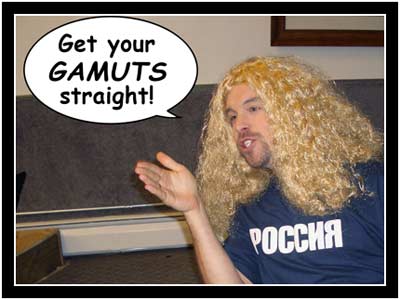Inside Joke
 Despite subscribing to the updates on Jane Espenson’s blog, I don’t really enjoy reading it. It’s mostly about writing spec scripts and what she had for lunch (what’s up with that?) The entries are short, however, and every once in awhile I pick up a worthwhile writing tip. Besides, she’s written episodes for some of my favorite TV series (Battlestar Galactica, Buffy the Vampire Slayer, Angel, Firefly, and Star Trek: Deep Space Nine), so that’s interesting.
Despite subscribing to the updates on Jane Espenson’s blog, I don’t really enjoy reading it. It’s mostly about writing spec scripts and what she had for lunch (what’s up with that?) The entries are short, however, and every once in awhile I pick up a worthwhile writing tip. Besides, she’s written episodes for some of my favorite TV series (Battlestar Galactica, Buffy the Vampire Slayer, Angel, Firefly, and Star Trek: Deep Space Nine), so that’s interesting.
Last week she discussed the defining characteristics of high-brow and low-brow jokes. High-brow jokes are ones that normally only high society types would understand. She demonstrated a joke she’d seen on Frasier. It was based on an opera I’d never heard of, Menotti’s Amahl and the Night Visitors –
And then, of course, on the ride home that night I caught an entire NPR segment on Menotti. I always wonder if things like that are coincidences or if they’re going on all around me and I’m just not tuned into them. Had I heard of Menotti’s opera before the one-two punch of blog-radio that day? Maybe I don’t remember because it wasn’t on my radar. No way to know.
– Low-brow jokes, on the other hand, appeal to a different class of people. She does a good job of deconstructing high- vs. low-brow. I never really stopped to consider that the distinction has nothing to do with whether the joke is good or bad, smart or dumb. The dividing line has to do with socio-economic boundaries. I inferred from her writing that a good joke, high-brow or low, probably shouldn’t even be understood by the opposite group.
The following day, Ms. Espenson continued the joke dissection by adding in “obscure-reference” jokes. She quotes a fellow writer who, in turn, describes one of his favorite obscure jokes from 3rd Rock:
“… [M]y all-time, ALL-TIME favorite obscure-reference joke was on 3rd Rock. They had a scene in which Dick Solomon (John Lithgow) goes to the airport to pick up his supervisor, the Big Giant Head, played by William Shatner. “How was your flight?” asks Lithgow. “Terrible,” Shatner replies. “There was some kind of gremlin on the wing!” Lithgow gasps: “THE SAME THING ONCE HAPPENED TO ME!!”
That’s a great one, I admit. I wish I had seen that episode, because I would have got that joke and felt proud of myself for doing so. That’s the great thing about “obscure reference” jokes; when you get them, you feel like you’re a part of the “in-crowd.” (Which is why I think we usually call them inside jokes.) There’s a flip side to inside jokes, though. Make them too obscure and no one will get them at all. (See also: Dennis Miller.)
I think Ze Frank tip-toed along the too-obscure line in an episode of The Show last week. Because I’m a Cowboys fan, I laughed out loud at the following setup and punch line:
“So who gets to play?”
“Well, this year, it’s the Colts and the Bears.”
“Why are they called that?”
“‘Cause all the teams are named after cool, badass things like Bears, and Jets, and Cowboys.”
…
“So, to play in the Super Bowl, the Colts and the Bears must be the best teams!”
“No, they don’t play enough games to figure that out. But they are the best at balancing a ball on the ground with their finger long enough for someone to kick it.”
“You’d think a cowboy’d be better at that than an animal.”
“You’d think, Timmy. You’d think.”
Get it? To be a part of this very small in-crowd, you’d have to:
A) Be an American football fan,
B) Know that, on average, kickers score the majority of points in a football game,
C) Know that The Dallas Cowboys were eliminated from the playoffs this year by The Seattle Seahawks (an animal),
D) Because Tony Romo bobbled the ball on a game-winning field goal attempt as he attempted to place it on the ground for the kicker.
Now that you’ve read the explanation, you might admire the obscurity of the joke. But does anyone ever laugh out loud after having a joke explained to them? Rarely.
All this reminds me of our second Doctrine video. It was riddled with inside jokes, but I’m responsible for the most obscure one. It was about colors, and to understand it, you had to have some passing familiarity with the subtractive properties of combined colors of light, the additive properties of paints or inks, and the way in which computers and printers deal with each (RGB vs. CMYK). We even referenced the joke at the end of the video with some red, green, and blue credits. I thought it was funny – and I expect those few that got it felt suitably rewarded – but I always worried that it flew over too many heads.
It’s like one of those situations where old friends get together to reminisce and laugh about the good ol’ days. Great fun for them, but confusing (and probably boring) for anyone listening in. You can explain the inside jokes, and you can describe your memories, but for those on the outside, the results will never be as good as being on the inside.

The gamut joke was the highlight of that festival for me, I remember trying to explain to someone why I thought it was funny. I think it was mostly the context. It’s unexpected.